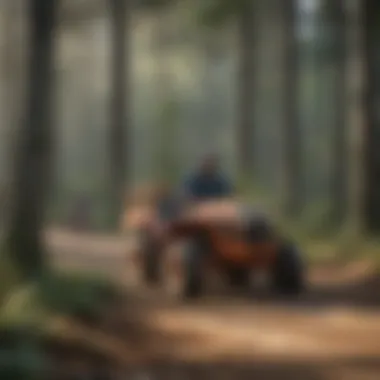Exploring the JHMR Bike Park: A Comprehensive Overview


Intro
The JHMR Bike Park stands as a testament to the balancing act between recreational enjoyment and environmental stewardship. Nestled amidst the breathtaking landscapes of Jackson Hole, Wyoming, the park offers a unique mix of adrenaline-inducing trails and a commitment to eco-friendly practices. This article aims to dissect the intricate details of the park's design and its broader implications for the local ecosystem and the biking community. By focusing on sustainable practices, woodland stewardship, and community involvement, we seek to present an in-depth perspective that appeals not only to biking enthusiasts but also to forestry professionals and academics.
Overview of Forestry Practices
Forestry encompasses the science and practice of managing forests, woodlands, and related resources to meet diverse societal needs while ensuring sustainability. Its core components include understanding forest ecology, managing tree growth, and addressing the social and economic aspects of forestry.
Importance of Forestry in Ecosystem Management
Forestry plays a pivotal role in ecosystem management. Healthy forestry practices contribute to biodiversity, soil health, and water quality, while also offering recreational spaces for communities. The management of forests can help mitigate climate change by enhancing carbon sequestration, making it an essential practice within the broader conversation about environmental conservation.
"Sustainable practices in forestry not only support biodiversity but also contribute to the wellbeing of local communities and economies."
Sustainable Forest Management
Sustainable forest management refers to managing forests in a way that maintains their biodiversity, productivity, and ecological processes, ensuring they can fulfill the social, economic, and environmental needs of future generations.
Principles of Sustainable Practices
The principles of sustainable practices involve:
- Maintaining ecosystem services
- Ensuring the regeneration of forests
- Conserving biodiversity
- Recognizing the rights and needs of local communities
These principles guide the operational strategies employed in parks like JHMR, ensuring that outdoor recreation does not come at the cost of ecological integrity.
Techniques in Sustainable Management
Effective techniques in sustainable management include:
- Selective logging rather than clear-cutting
- Implementing buffer zones around water bodies
- Using native species for reforestation
These techniques ensure that the ecological balance is preserved while providing pathways for recreational activities.
Woodland Stewardship Strategies
Woodland stewardship refers to the responsible management of forested lands to ensure their health and sustainability.
Importance of Woodland Stewardship
Such stewardship is crucial for maintaining biodiversity and ensuring that forests can continue to provide resources for future generations. This includes not only timber but also recreational opportunities, tourism, and vital ecosystem services.
Best Practices for Landowners
For landowners, best practices include:
- Engaging in regular land assessments
- Developing management plans that consider both conservation and economic viability
- Participating in community or regional forestry programs
These practices empower local stakeholders to contribute positively to the sustainability of their natural resources.
Foreword to JHMR Bike Park
The JHMR Bike Park holds a critical position in the realm of outdoor recreation, especially for biking enthusiasts and forestry professionals. Situated in Jackson Hole, Wyoming, this park is not just a venue for sport; it represents a harmonious blend of nature and recreation. The design and layout of the bike trails exemplify careful planning, aimed at enhancing user experience while ensuring minimal ecological footprint.
Understanding the concept and historical context of the JHMR Bike Park sets the stage for deeper discussions on its features and impact. This section will provide a foundation for the subsequent explorations concerning trail types, eco-friendly practices, and community engagement. By analyzing these aspects, readers will gain insights into not only the park's recreational offerings but also its sustainability initiatives.


Concept and Vision
The concept behind the JHMR Bike Park is rooted in the belief that outdoor sports can coexist with environmental consciousness. The vision integrates a panoramic view of the natural landscape with the thrill of mountain biking. This approach is aimed at promoting healthy lifestyles while preserving the ecological integrity of the area. The park was designed with a focus on inclusivity, ensuring that riders of various skill levels can enjoy the natural scenery and improve their biking skills. It fosters a sense of community, promotes outdoor activities, and encourages stewardship of the land.
Historical Context
The historical context of the JHMR Bike Park is essential to understanding its significance today. The emergence of mountain biking as a popular sport in the late 20th century catalyzed the development of dedicated bike parks. The Jackson Hole area, with its rugged terrain and stunning views, quickly became a preferred location for such developments. The inception of the bike park is marked by community discussions that prioritized sustainable access to nature while also accommodating the growing interest in mountain biking.
Over the years, the park has evolved, adapting to the needs of its users and the principles of environmental stewardship. It serves as a model for incorporating recreational facilities into existing ecosystems. As interest in outdoor recreation continues to grow, understanding this backdrop helps to appreciate the ongoing developments and future prospects of the JHMR Bike Park.
Park Design and Features
Park design is critical to creating a successful environment for bikers and nature lovers alike. The JHMR Bike Park blends outdoor recreation with ecological stewardship. Its design focuses on enhancing user experience while also slowing the impact on the surrounding biodiversity. Each trail is thoughtfully constructed to complement the natural landscape, ensuring both enjoyment and safety for its users.
Trail Layout and Types
The trail layout at JHMR Bike Park divides the park into sections catering to various skill levels. This supports a diverse range of visitors, from beginners who are just scopring their biking skills to advanced riders looking for a challenging experience. The diversity in trail types fosters a more inclusive environment, encouraging a larger community of biking enthusiasts.
Beginner Trails
Beginner trails are essential for those new to mountain biking. They feature gentler slopes and smoother terrain, making them approachable for riders who may lack experience. One of the key characteristics of these trails is their accessibility. They often have clear signage and little technical difficulty, allowing new riders to gain confidence.
- Unique Feature: The routes are often surrounded by natural barriers, which add to the scenic beauty without making the riding experience overwhelming.
- Advantages: These trails help in nurturing new interest in biking, ensuring that beginners feel welcome.
- Disadvantages: Due to the design intended for beginners, they may lack the thrill that seasoned bikers seek, thus carrying potential limitations on long-term engagement with the park.
Intermediate Trails
Intermediate trails are a step up, offering a mix of terrain that encourages skill development. These trails introduce moderate jumps and obstacles, challenging riders without being overly daunting. One notable characteristic is the variability in trail conditions, allowing for diverse riding experiences.
- Unique Feature: They often include switchbacks and elevation changes that enhance the technical complexity.
- Advantages: They serve as a bridge for beginners to transition to more demanding trails, catering well to those looking to improve their skills.
- Disadvantages: Intermediate trails require a certain proficiency, which may dissuade some beginners from attempting them.
Advanced Trails
Advanced trails at JHMR Bike Park are designed for experienced bikers seeking extreme challenges. They include steep descents, technical rock gardens, and tight corners, testing riders' limits. The thrill is a key reason for their popularity among veterans in the sport.
- Unique Feature: Many advanced trails incorporate natural elements such as roots and rocks, providing an authentic mountain biking experience.
- Advantages: These trails attract seasoned bikers and promote an adrenaline-fueled biking culture throughout the park.
- Disadvantages: Yet they can be intimidating for those less experienced, which could limit participation from a broader public.
Facilities and Amenities
Facilities and amenities at the JHMR Bike Park enhance user convenience and safety. They allow visitors to have a comprehensive biking experience from arrival to departure.
Parking
The parking facilities are spacious and designed to accommodate a high volume of visitors. They are positioned close to the park entrance, making access more efficient. This contributes to the overall flow of traffic in and out of the park.
- Unique Feature: Designated spots for larger vehicles, such as RVs and trailers, making the park accessible to diverse visitors.
- Advantages: Easy accessibility promotes higher attendance and makes organizing group rides manageable.
- Disadvantages: However, during peak times, the lot can fill quickly, leading to congestion and longer wait times.
Rest Areas
Rest areas are strategically placed throughout the park. They provide crucial spaces for bikers to recharge between trails. These areas often include benches and shade structures, ensuring comfort during breaks.
- Unique Feature: Some rest areas also feature bike racks and repair stations for minor adjustments.
- Advantages: They contribute to a more relaxed experience for visitors, allowing time to enjoy the scenery and recover before resuming biking.
- Disadvantages: They may not always be available in high-traffic sections, which can lead to overcrowding.
Repair Stations
Repair stations serve as a critical component for the park's utility. They provide tools and pumps for minor bike repairs, thus ensuring that riders can continue their experience without major interruptions.


- Unique Feature: Many stations are equipped with self-service tools, offering independence during repairs.
- Advantages: This feature promotes safety and ensures that bikers are prepared for unexpected issues mid-ride.
- Disadvantages: Limited staff support may mean that issues requiring expert attention cannot be resolved on-site, possibly leading to frustration.
Sustainability and Environmental Impact
Sustainability and environmental impact are crucial considerations for recreational areas like JHMR Bike Park. These aspects ensure that the park serves the biking community while preserving the natural surroundings. A sustainable approach allows for continuous enjoyment of the park without degrading the environment. It also fosters a connection between visitors and nature, promoting awareness about ecological conservation.
Eco-Friendly Practices in Design
Designing the JHMR Bike Park with eco-friendly practices in mind is essential. One significant strategy involves using natural materials for building trails and facilities. This method reduces pollution and supports the park's integration into the landscape.
Moreover, the layout of the trails is carefully planned to minimize disruption to local flora and fauna. Specific areas are designated as no-ride zones to protect delicate habitats. Additionally, the park employs erosion control measures, such as terracing and drainage solutions. These initiatives help maintain the integrity of the trails and reduce sedimentation in nearby waterways.
Other practices include creating designated areas for rest and maintenance that do not interfere with wildlife. Proper signage informs visitors about the rules and the importance of staying on the trail. This mitigates the risk of damaging the local ecosystem due to off-trail activities.
Biodiversity and Conservation Efforts
The park's commitment to biodiversity is another vital aspect of its sustainability efforts. Various conservation programs are in place to protect local species and habitats. These programs involve collaboration with environmental organizations and local Sscientists.
One notable effort includes monitoring wildlife populations to understand their dynamics in relation to park usage. This data informs decisions about trail management and potential adjustments to park offerings. Such research is fundamental in ensuring that recreational use does not come at the expense of wildlife.
Another focus is on native plant restoration initiatives. The park encourages the growth of indigenous plants that support local ecosystems. This not only helps the environment but also enhances the aesthetic appeal of the trails, creating a more enjoyable experience for visitors.
"A balance between recreation and preservation is key to ensuring the long-term viability of JHMR Bike Park."
By integrating these elements, the JHMR Bike Park becomes a model for sustainable outdoor recreation. The practical measures taken underscore the importance of ecological awareness in both design and user experience, ensuring that this natural resource remains vibrant for future generations.
User Experience and Community Engagement
User experience at the JHMR Bike Park involves the satisfaction and enjoyment of riders as they navigate through its various trails and facilities. Engaging with the community is crucial as it fosters a sense of belonging and encourages sustainable practices. Understanding visitor demographics helps in tailoring experiences that cater to diverse groups. Factors such as skill levels, age ranges, and preferences can affect how individuals enjoy the park. Therefore, it is essential to design trails and amenities that meet the needs of all riders.
Community engagement enhances the overall attractiveness of the park. Local riders often establish connections through shared experiences, creating a network of support for casual and professional bikers alike. Regular activities help to maintain interest and involvement, fostering a community spirit that benefits the park's long-term goals. These events can also serve educational purposes, informing participants about responsible biking and ecological preservation.
Visitor Demographics
Understanding visitor demographics allows for a deeper insight into the JHMR Bike Park's user base. The park attracts individuals ranging from novice riders to advanced bikers. Families may visit during weekends, while more experienced riders come during weekdays, seeking a quieter experience. This diversity in visitors adds richness to the park's atmosphere.
Age also plays an important role in demographic considerations. Younger participants often look for thrilling experiences, while older riders may prioritize comfort and safety. By recognizing these trends, the park can adapt its offerings. For example, more guided tours or safety workshops can be organized to cater to inexperienced riders. This inclusivity ensures that everyone feels welcomed.
Community Events and Initiatives
Local Rides
Local rides are organized outings that encourage bikers to experience the trails in a communal setting. These rides contribute significantly to promoting the park as an essential gathering place for enthusiasts. The key characteristic of local rides is their accessibility. They are often scheduled at varying difficulty levels, accommodating both beginners and seasoned bikers.
A unique feature of local rides is the social aspect. Riders not only enjoy the trails but also engage with each other, sharing tips and experiences. This also fosters camaraderie among participants. However, it may lack a structured learning format for less experienced riders, which is something to consider for future events.
Workshops
Workshops at the JHMR Bike Park focus on enhancing riding skills and environmental education. These sessions provide detailed instruction that can greatly improve the capabilities of participants. The key characteristic of workshops is their hands-on approach. Participants have the opportunity to practice skills in real-time, with seasoned instructors guiding them.
A unique advantage of workshops is their focus on environmental stewardship. They often include information on the park’s ecosystem and how bikers can minimize their footprint. On the downside, workshops may only attract those specifically interested in improving their skills, which could limit broader community involvement.
Volunteer Opportunities
Volunteer opportunities at the bike park offer locals a way to contribute actively to the maintenance and enhancement of the park. This engagement reflects a strong commitment to conservation. The key aspect of these opportunities is that volunteers can participate in trail building, maintenance, and event organization.


A standout feature of volunteering is its potential to foster a deeper connection between participants and the park. Volunteers often develop a sense of ownership, resulting in dedicated advocates for the park. However, attracting volunteers can be challenging. Some may hesitate due to time commitments or may not visibly see the direct impact of their efforts. Thus, improving awareness about the benefits of participation would be advantageous.
"Community involvement is essential in creating a sustainable environment within the JHMR Bike Park. Strong relationships formed here can enhance the overall experience for all riders."
A combination of these community engagement efforts enhances the user experience at JHMR Bike Park. The continued focus on inclusivity and sustainability ensures the park meets the needs of both riders and the environment.
Comparative Analysis
Comparative analysis is vital for understanding the unique attributes of the JHMR Bike Park relative to other biking facilities. In an era of increasing interest in outdoor recreational spaces, this analysis sheds light on various factors such as design philosophy, user experience, and ecological impact. Evaluating these elements integrates a broader perspective on park management and can inform future enhancements for JHMR.
JHMR Bike Park vs. Other Parks
To comprehend the distinctiveness of JHMR Bike Park, it is essential to compare it with similar biking parks. The park’s trail system, for example, is carefully designed to cater for all levels of riders. This level of inclusivity is evident in facilities such as the easy trails designed for novices, challenging intermediate loops, and advanced technical tracks.
Unlike parks such as Whistler Bike Park in Canada or Park City Bike Park in Utah, JHMR prioritizes not just the physical challenges of biking, but also the sustainability of its practices. The integration of eco-friendly practices into trail creation ensures that the local ecosystem is not adversely affected. Other parks may not offer as much focus on biodiversity as JHMR does, which can be a key selling point for environmentally-conscious cyclists.
Lessons Learned from Other Parks
Numerous parks provide valuable lessons that JHMR Bike Park can incorporate. For instance, facilities like the Mount Hotham Bike Park in Australia emphasize user engagement through community-driven events. JHMR could enhance its community initiatives by organizing recurring events that encourage local participation and foster a sense of ownership among riders.
Another vital aspect is the importance of effective signage and trail maintenance that other parks maintain. Projects in places such as the Vail Parks in Colorado have proved that clear trail markings significantly improve safety and user experience. JHMR can benefit greatly from adopting better trail management practices based on insights from such parks.
"The comparisons not only illustrate the unique offerings of JHMR, but they also underscore the importance of ongoing improvement based on peer insights."
By taking these lessons into account, JHMR Bike Park can further solidify its standing as a premier riding destination while balancing the needs of its riders with sustainable forestry practices.
Future Prospects of JHMR Bike Park
The future of the JHMR Bike Park presents significant opportunities for both the local environment and the biking community. With the growing popularity of outdoor recreation, understanding the potential developments within the park is essential for stakeholders, including local government, conservationists, and visitors. This section explores upcoming projects and long-term sustainability goals that are set to shape the park and ensure its positive impact on the environment and the community.
Upcoming Projects and Developments
Several projects are underway or in planning stages at the JHMR Bike Park. These aim to enhance the rider experience and maintain ecological integrity.
- New Trails: Plans are in place to construct additional trails catering to various skill levels. This expansion will diversify the park's offerings, making it accessible to more riders.
- Infrastructure Improvements: Projects include upgrading existing facilities like restrooms and repair stations. This will enhance user comfort and convenience.
- Safety Initiatives: In response to user feedback, initiatives are being developed to improve trail signage and overall safety measures. This includes increased visibility and educational signage about safety and environmental awareness.
- Reforestation Projects: To mitigate previous impacts on local ecosystems, the park has collaborated with local organizations to plan reforestation activities. This ensures the preservation of native flora and fauna.
These developments highlight a commitment to meeting the needs of riders while maintaining environmental standards.
Long-Term Sustainability Goals
The long-term sustainability goals at JHMR Bike Park focus on ensuring that both the park and its surrounding environment thrive for future generations.
- Ecosystem Management: Maintening natural habitats is a priority. This includes regular assessments of trail impacts and implementing measures to protect vulnerable species.
- Resource Efficiency: Utilizing renewable resources and promoting eco-friendly practices among visitors are at the forefront of strategic goals. This involves reducing energy usage at facilities and encouraging zero-waste practices during community events.
- Engagement and Education: The park aims to foster community involvement through educational programs about local ecosystems and responsible biking practices. This helps cultivate a culture of stewardship among riders.
- Collaboration with Experts: Ongoing partnerships with environmental scientists and community organizations will support these sustainability goals. These alliances will help ensure that best practices are followed and adapted to the park’s needs.
"The JHMR Bike Park represents a fusion of recreation and ecological responsibility, paving the way for future outdoor endeavors."
In summary, the future of the JHMR Bike Park is bright, centered on thoughtful growth and strong environmental principles. These efforts not only improve the biking experience but also ensure the park remains a cherished resource for the community and the natural world.
The End
The conclusion of this article serves as a vital summary of the JHMR Bike Park's significance. It consolidates the information discussed throughout the sections. By reflecting on the design, usage, sustainability efforts, and community involvement, we gain a holistic view of how JHMR Bike Park operates and contributes to both the local environment and biking culture.
Summary of Key Insights
Several key insights emerge from our exploration of the JHMR Bike Park. Firstly, the well-thought-out layout of trails caters to a wide range of skill levels, emphasizing inclusivity in outdoor recreation. The park's commitment to sustainable practices showcases how recreational spaces can be developed with minimal ecological disruption. Furthermore, community engagement initiatives reflect a strong bond between local enthusiasts and park management. These elements collectively highlight the bike park as not merely a recreational facility but as a model for environmentally responsible outdoor spaces.
"The blend of adventure and conservation at JHMR Bike Park underscores the growing importance of sustainable recreational spaces."
Call to Action for Conservation
Ultimately, the future of parks like JHMR hinges on the collective responsibility of its users. A call to action for conservation emphasizes the necessity of preserving such environments for future generations. Engagement from the biking community in conservation efforts is critical. Participating in local clean-ups, supporting biodiversity initiatives, and advocating for responsible trail usage can significantly impact the sustainability of outdoor recreational spaces.
Encouraging groups and individuals to become stewards of the land fosters a deeper connection to nature. By paying heed to both our environment and recreational pursuits, we can ensure that places like JHMR Bike Park thrive for generations to come.







